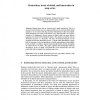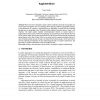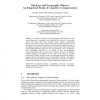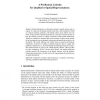COSIT
1999
Springer
14 years 8 months ago
1999
Springer
Traditionally, depictions and descriptions have been seen as complementary; depictions have been preferred to convey iconic or metaphorically iconic information whereas description...
COSIT
1999
Springer
14 years 8 months ago
1999
Springer
Landmarks are significant in one’s formation of a cognitive map of both physical environments and electronic information spaces. Landmarks are defined in physical space as having...
COSIT
1999
Springer
14 years 8 months ago
1999
Springer
Where some have attempted to apply cognitive methods to the study of geography, the present paper is designed to serve as a starting point for applying methods of geographic ontolo...
COSIT
1999
Springer
14 years 8 months ago
1999
Springer
COSIT
1999
Springer
14 years 8 months ago
1999
Springer
Previous recent research on human wayfinding has focused primarily on mental representations rather than processes of wayfinding. This paper presents a formal model of some aspect...
COSIT
1999
Springer
14 years 8 months ago
1999
Springer
We extend the theory about terminological default reasoning by using a logical base language that can represent spatioterminological phenomena. Based on this description logic lang...
COSIT
1999
Springer
14 years 8 months ago
1999
Springer
In qualitative spatial reasoning, the last ten years have brought a lot of results on theories of spatial properties and relations taking regions of space as primitive entities. In...
COSIT
1999
Springer
14 years 8 months ago
1999
Springer
COSIT
1999
Springer
14 years 8 months ago
1999
Springer
Spatial information is information bound to spatial entities such as regions. It is based on the spatial structure alone (the valley includes the field) or connects thematic predic...







